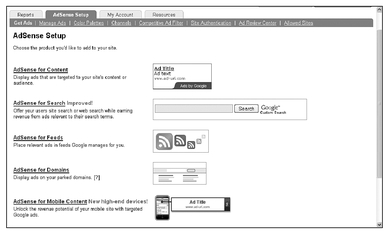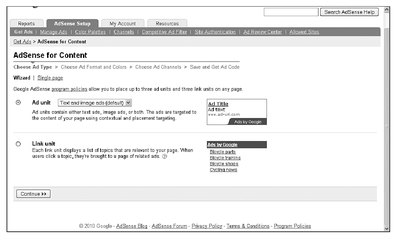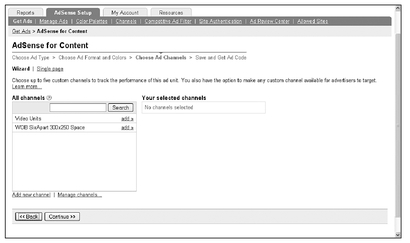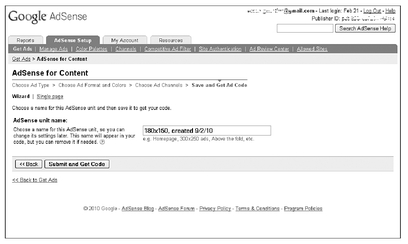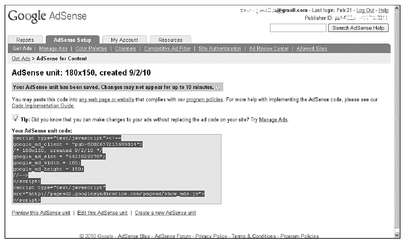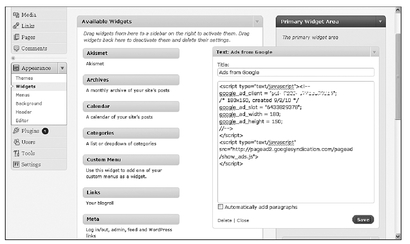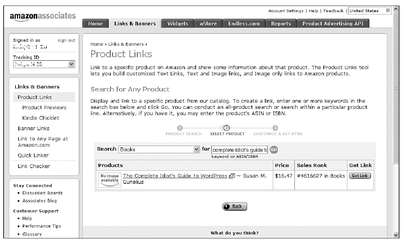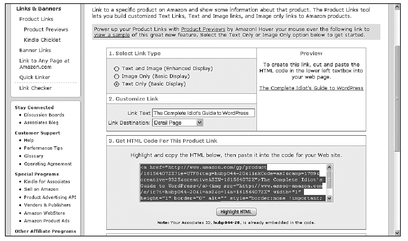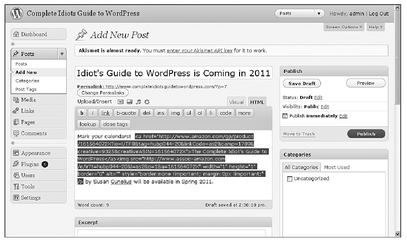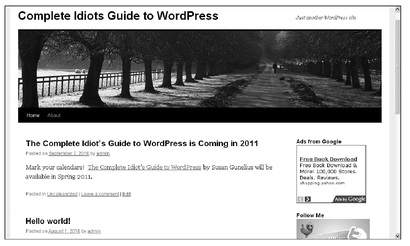Chapter 24
Advertising, Affiliate Programs, and More
In This Chapter
• Understanding ad payment models and ad formats
• Choosing an ad program or network
• Cutting out the middleman: selling ad space
• Joining affiliate or sponsored post programs
As you begin to search for ways to make money from your blog, you’ll discover a wide variety of programs and opportunities. In order to effectively evaluate them, you need to understand the types of ad formats and payment models you’re likely to come across.
This chapter teaches you about the most common monetization programs and payment models available for your blog. You also learn how to effectively sell ad space on your blog to cut out the middleman and keep 100 percent of your earnings.
Types of Ad Payment Models
When it comes to online advertising, advertisers pay publishers in a variety of ways. Payment typically depends on clicks, impressions, or actions (more on these in a little bit). Alternately, an advertiser might agree to pay you a flat fee to publish an ad for a predetermined length of time.
It’s important to understand that the amount of money you can make from blog advertising depends on two primary variables: traffic and placement. The more traffic your blog gets, the more advertisers are willing to pay for ad space on your blog, and the more money you can make from clicks, impressions, and actions. Furthermore, advertisers usually pay more for ads placed in positions where the most people will see them.
Here are some of the most popular ad payment models:
Pay-per-click: Some advertisers only pay you for each click their ad gets on your blog, which is referred to as pay-per-click (PPC) advertising.
PROCEED WITH CAUTION
Don’t click on pay-per-click ads on your blog yourself or ask others to click on them for you. This practice is a violation of pay-per-click advertisers’ policies, as discussed in Chapter 23.
Pay-per-impression: With pay-per-impression (PPM) ads, you earn money every time the ad displays on your blog. For example, if a pay-per-impression ad appears in your blog’s sidebar, an impression is counted every time someone views a page on your blog that includes your sidebar.
Pay-per-action: Pay-per-action (PPA) advertisers pay every time a specific action is completed related to their ads. For example, if a visitor to your blog clicks on a pay-per-action ad, which takes them to an inquiry form on the advertiser’s website, the visitor needs to complete and submit the inquiry form before you’re paid.
Popular Ad Formats for Blogs
Ads come in various shapes and sizes and can appear just about anywhere within your blog. The choice is yours, but don’t forget to follow the suggestions and warnings in Chapter 23 to ensure you publish ads that add value to the user experience on your blog rather than damaging it. The last thing you want to do is drive traffic away from your blog because of the ads you publish.
Display ads: Display ads include any kind of graphic or image ads. They can be static images or flash-animated graphics. Display ads often appear in the header, in the footer, in the sidebar, between posts, or within posts. Also, display ads can be pay-per-click, pay-per-impression, or pay-per-action ads, depending on the advertiser or advertising program.
Text ads: Text ads look like regular hyperlinks. They could appear within your blog posts, in your blog’s sidebar, in your blog’s footer, or anywhere else you can insert a text link. Many bloggers like text links because they take up very little room on their blogs.
PROCEED WITH CAUTION
Not only do text link ads fail to disclose to visitors that they are, in fact, clicking on an ad—which could annoy them when they realize it—but text link ads also are disliked by search engines, which view paid links as spam and could negatively affect your blog’s search traffic.
Video ads: Video ads are one of the newer forms of blog monetization. Typically, they’re pay-per-click ads that might require visitors to simply click on the ad for you to be paid. It’s important that you read the earnings method requirements for specific video advertising opportunities because advertisers are testing new payment models and methods all the time.
Which Ad Program Is Right for You?
There are many advertising programs bloggers can join in an effort to make money from their blogs. While some programs require that your blog receives a minimum amount of traffic each month in order to participate, other programs are open to anyone who publishes a blog or website.
In other words, there are money-making opportunities for every blogger. You just have to be willing to do your research, find the programs that match your audience’s wants and needs, and experiment with ad content, placement, and payment models to learn what delivers the best earnings for you.
Popular Ad Programs and Networks
A variety of advertising programs and networks are open to bloggers to help you get started in your efforts to become a revenue-generating blogger. Appendix C’s “Sites to Help Monetize Your Blog” section gives you a list of some of the more popular ad programs and networks.
PROCEED WITH CAUTION
Keep in mind that program guidelines and participation requirements can change at any time, so be sure to check each website to learn the current restrictions.
Some blog advertising programs offer pay-per-click, pay-per-impression, or pay-per-action opportunities, while others only offer one type of payment model. Similarly, some programs offer display ads or text link ads, while others offer a wide variety of options for both display and text ads as well as video. Be sure to read through all the options and experiment with the monetization opportunities that fit best with your blog’s content, design, and audience in order to best position yourself to reach your long-term blogging goals.
Inserting Google AdSense Ads into Your Blog’s Sidebar
Most advertising programs for bloggers work in a similar manner. You sign up for an account, copy some code provided to you through your new account, and paste it into your blog where you want ads to appear.
The following example shows you how to create and insert code for a Google AdSense ad unit into your blog’s sidebar, so you can see how easy it is. Different ad programs are likely to have specific nuances that affect how you create and insert their ad code into your blog, but this example should take some of the confusion out of the process.
INSIDER SECRET
Ad programs such as Google AdSense might place ads contextually, meaning the ads are served based on the content found on the page where they’re displayed.
First, log in to your Google AdSense account at
www.google.com/adsense and click the
AdSense Setup tab in the top navigation bar. This opens the AdSense Setup page, shown in Figure 24-1.
Figure 24-1 You can create a new ad unit from the Google AdSense Setup Page.
Click the link that matches the type of ad unit you want to create for your blog to open the corresponding configuration page. In this example, a new AdSense for Content ad (the most popular ad unit used by bloggers) is created, as shown in Figure 24-2.
Select the type of AdSense for Content ad you want to create from the options provided, and click the Continue button to set up the design of your ad unit, as shown in Figure 24-3.
Figure 24-2 Choose the type of ad unit you want to place on your blog.
Figure 24-3 Choose the design settings for your new ad unit.
Click the Continue button when your configurations are complete, and choose a channel (or create a new channel) if you want to be able to track this ad unit as part of a larger program, as shown in Figure 24-4.
Figure 24-4 Choose the channel you want to associate your ad unit with for tracking purposes.
If you don’t want to specify a channel, just click the Continue button to give your ad unit a name, as shown in Figure 24-5.
Figure 24-5 Give your AdSense ad unit a name so you can identify it in your account later.
Click the Submit and Get Code button to access your AdSense unit code, as shown in Figure 24-6.
Figure 24-6 Copy the code for your new AdSense ad unit so you can insert it into your WordPress blog.
Highlight all the content in the Your AdSense Unit Code text box, and copy it. This is the code you need to insert into your WordPress blog in order for ads to begin appearing to visitors.
Next, log in to your WordPress dashboard, and select the Widgets link in the Appearance section of your dashboard’s left menu to open the Widgets page. Click and drag a new text widget into the position in your blog’s list of sidebar widgets where you want your new ad unit to appear. (You can also simply paste the ad code into an existing text widget if you prefer.) Paste the ad code you copied from your Google AdSense account into the new text widget, as shown in Figure 24-7. You can also give your new text widget a name if you’d like.
Click the Save button at the bottom of the new text widget and then view your live blog to see your ad unit in its new place on your blog, as shown in Figure 24-8.
Figure 24-7 Paste your ad unit code into a text widget.
Figure 24-8 Your new ad unit appears in your blog’s sidebar.
Keep in mind, you might need to refresh your browser to see the new ad unit on your live blog.
PROCEED WITH CAUTION
Some advertising programs might have a delay in serving ads to your new ad unit, particularly if your site has to be indexed for contextual advertising, so don’t be surprised if it takes a day or so before ads begin appearing in your live blog.
Selling Ad Space Directly
It can be difficult for beginner bloggers to attract advertisers without the help of an advertising program or middleman, but it can be done. As traffic to your blog grows, you’ll be able to attract more advertisers and increase your advertising rates. As long as you set realistic expectations for your earnings potential from selling ad space directly to advertisers, you’ll be successful.
Pros and Cons of Selling Directly
The biggest benefits to selling advertising space directly to advertisers is being in control and keeping all the money you make. When you participate in advertising networks and programs, you only make a percentage of the program’s overall earnings, or you have to give up a percentage of your earnings to the advertising program. Both scenarios mean you lose money, but that’s not a problem when you sell ad space directly to advertisers.
On the other hand, bloggers whose blogs don’t attract at least tens of thousands of visitors each month can have a very difficult time attracting advertisers to their blogs. Advertising networks and programs give you access to advertisers smaller bloggers can’t always get on their own.
Furthermore, when you participate in a blog advertising network or program, you significantly reduce the amount of work you have to do. Often you just have to sign up, copy some ad code, paste it into your blog, and you’re done. When you sell ad space directly, you have to promote your ad space for sale, communicate with advertisers, approve ads, handle payment processing, respond to problems, and do the technical work to publish and remove ads based on the specific run time of each ad published on your blog. If you don’t have a lot of free time, selling ad space directly could be challenging for you.
Many beginner bloggers choose to pursue the best of both worlds. They offer ad space for sale directly on their blogs, knowing it’s unlikely they’ll get a lot of inquiries, and they also participate in one or more advertising networks or programs. Even some of the most popular and well-trafficked blogs diversify their earnings by participating in multiple revenue-generating activities. That’s just good business.
Setting Rates
There’s no single recipe for success when it comes to setting advertising rates on your blog, particularly if your blog is new or not well trafficked yet. It is important to set the rates for your ad space competitively, so take some time to visit other blogs about your topic and that attract similar audiences. Search those sites to see if they offer advertising rates. This can help you set competitive rates for your own ad space.
QUICK TIP
Search for blogs similar to yours on a site like
BuySellAds.com (discussed in detail later in this chapter) to see what advertising rates those blogs are charging. Use that information as a benchmark when setting rates for your own blog.
It’s a good idea to set your rates low at first in order to attract the most advertisers. For example, if your blog traffic is under 1,000 page views per day, you could set a rate of $10 per 30 days for a 125×125 pixel button ad in your blog’s sidebar (above the fold) or $20 for a 250×300 pixel square ad in your sidebar. Set rates for premium locations (above the fold or in the header) higher than other locations on your blog.
Using a Middleman
As mentioned earlier in this chapter, it can be difficult for new bloggers to attract advertisers. Fortunately, there are some companies that link online publishers with advertisers so even low-trafficked blogs can connect with advertisers. An advertising program like the one offered by
BuySellAds.com (
www.buysellads.com), for example, is an excellent option for small blogs.
You can sign up for a free publisher account on
BuySellAds.com, create a listing for your blog, enter the ad sizes and placements you’re willing to accept on your blog along with pricing for each, and you’re done! Be sure to include a great description and tag your blog listing with keywords related to your topic and audience that advertisers are likely to search for. Also, take the time to see what other blogs similar to yours in terms of traffic and audience are charging for ad space so you can set competitive fees.
A site like
BuySellAds.com takes care of all the technical aspects of advertising on your blog. You paste code into your blog once, and
BuySellAds.com does the rest. However,
BuySellAds.com does keep a percentage of your earnings from each ad sold on your blog. If you have trouble attracting advertisers to your blog, using a middleman like
BuySellAds.com might turn your blog from a site that earns no money to one that earns a bit each month. Of course, you can stop using
BuySellAds.com at any time.
Automating Ad Space Sales
Selling ad space directly to advertisers can take up a lot of your time. Fortunately, some WordPress plug-ins make it easier to manage the monetization of your blog through ads. If you visit the WordPress Plugin Directory and type in keywords such as “ad” or “advertising,” you’ll find many free plug-ins that can help you sell and manage ad space on your blog.
The free WP125 plug-in (
wordpress.org/extend/plugins/wp125) makes it very easy to sell and manage 125×125-pixel button ads on your blog. You can configure the placement and quantity of ads on your blog as well as track clicks for pay-per-click ads. Furthermore, you can automate the process of taking down expired ads as well as set up e-mail notifications when expired ads are removed from your live blog. Even unsold space is automatically promoted on your blog with a special “Your Ad Here” image.
For more control and customization, the OIOpublisher plug-in (
www.oiopublisher.com), which is offered for a reasonable fee, provides complete automation of your direct advertising sales and publishing. Using OIOpublisher, you can sell and manage display ads of all sizes, text link ads, and even paid posts. You can even automate payments through PayPal with OIOpublisher. Also, you can track ad performance and set up ads so they’re only displayed to specific audiences. It’s easy to create custom ad zones with different prices and options. If you’re serious about selling ad space directly, this is a great plug-in to help you.
Affiliate Programs
Affiliate advertising is a popular blog monetization method. Many companies pay bloggers to become their affiliates. Affiliate advertising programs also link online publishers, such as bloggers, with a wide variety of companies looking for affiliates.
In simplest terms, bloggers can become affiliates of one or more companies and place ads for those companies on their blogs. When a visitor clicks on one of those ads and completes a predetermined action (for example, makes a purchase), the blogger is paid a percentage of the sale or a predetermined fee. Companies of all sizes use affiliates to advertise their products across the web.
While some affiliate programs have participation requirements related to your blog’s traffic, others are open to all online publishers. Furthermore, some affiliate programs are open for anyone to join, but the specific companies that participate in those programs that are looking for affiliates might have their own requirements you have to meet in order to work with them. It’s important that you read the current guidelines and restrictions for not only any program you join, but also for each specific affiliate advertiser you consider working with.
Finding an Affiliate Program and Network
Appendix C’s “Sites to Help Monetize Your Blog” section offers a list of some of the most popular affiliate programs and networks for bloggers.
Inserting Amazon Affiliate Links in Blog Posts
Many affiliate advertising programs simply require that you create an account, copy some ad code, and paste it into your blog to begin serving their ads to your audience. However, some unique opportunities are available to you as well. For example, as an Amazon Associate, you can include your affiliate ID in text links within your blog posts so you can make it easy for people to find and purchase products while they’re reading a post on your blog that refers to a specific product.
INSIDER SECRET
If you’re already logged in to Amazon when you start your blog post, you can easily get ad code for any Amazon product with a simple mouse click and without leaving your blog using the Amazon Associates Site Stripe (
affiliate-program.amazon.com/gp/associates/promo/sitestripe.html). It even adds a handy toolbar to your web browser!
To begin, log in to your Amazon Associates account and click the Links & Banners tab in the navigation bar to open the Product Links page, shown in Figure 24-9.
Figure 24-9 Search for the product you want to link to in the Amazon Associates Product Links page.
Use the Search drop-down menu and keyword text box to enter search criteria to find the product you’re looking for. Click the Go! button to see your search results, as shown in Figure 24-10.
Figure 24-10 Click the Get Link button to get the link code for the product you want to advertise on your blog.
When you find the product you want to link to from your blog post, click the Get Link button next to it. The Customize and Get HTML page opens, as shown in Figure 24-11.
Figure 24-11 Copy the ad code provided.
Click the radio buttons and drop-down menu to customize your ad link. You can see how your ad will look in the Preview section of the page. When the ad looks the way you want it to on your blog, highlight all the text in the Get HTML Code For This Product Link text box. This is the code you need to insert into your blog post.
Log in to your WordPress dashboard, and navigate to the blog post where you want to display the Amazon ad. For text link ads, be sure you’re in the HTML editor by clicking on the HTML tab in the top right of the post editor. Position your mouse where the text link should begin, and paste the code you copied from your Amazon Associates account into that position, as shown in Figure 24-12.
Once your post is published, the Amazon product link will look like all other links on your blog, as shown in Figure 24-13, but the actual link includes your Amazon Associates ID in it, so you’ll get credit if someone who follows that link from your blog post to Amazon makes a purchase.
Figure 24-12 Insert Amazon text link ad code into your HTML blog post editor.
Figure 24-13 An Amazon text link ad looks like all other links on your blog.
Paid Reviews and Sponsored Posts
As discussed in Chapter 23, if you publish blog posts in return for monetary or other forms of compensation, you need to disclose that relationship to stay compliant with the law and the ethics of the social web. If you’re willing to do that, writing posts for payment can be a great way to make money from your blog. The trick is to be sure you publish paid posts that actually add value to your blog and your audience.
Paid reviews are simply reviews of any kind of products, services, companies, or other items or entities published in return for compensation. Sponsored posts don’t necessarily have to be reviews. Instead, they’re considered any blog post published in exchange for compensation. In other words, if you’re getting paid by a company or individual to write a post, you’re participating in paid posting, paid reviews, and/or sponsored post advertising, and you need to disclose those activities on your blog.
PROCEED WITH CAUTION
Be sure any paid posting program you join requires that participants provide full disclosure within paid posts to ensure you’re working with a reputable company.
A number of websites connect online publishers, such as bloggers, with companies and people who are looking for sites willing to publish content about their products and services. Appendix C’s “Sites to Help Monetize Your Blog” section gives you sites where bloggers can find paid posting opportunities.
Some paid posting programs pay you as soon as your published post is approved, while others require you to reach a payout threshold to receive payment. Always take the time to not only read the guidelines set by the paid posting program but also of each specific opportunity you consider to ensure it’s right for your blog.
Also, be careful not to publish too many paid posts on your blog or your audience might begin to think you have nothing to offer but paid reviews and posts that read like ads. Remember, without valuable content, no one will want to read your blog, and without readers, you won’t be able to attract any advertisers or make any money at all.
The Least You Need to Know
• Advertisers could pay you each time a visitor clicks on an ad on your blog, each time an ad is displayed on your blog, or each time a visitor completes a specific action after clicking on an ad on your blog.
• You keep all your earnings if you sell ad space directly, but joining an ad program can help you sell more ad space.
• Affiliate advertising and publishing paid posts are popular blog monetization methods, but remember to disclose compensated links and posts as such.





